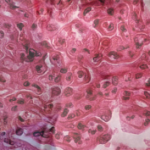Understanding the role the IFN signature plays in predicting prognosis and choosing therapy for patients with lupus will undoubtedly be part of the future of rheumatology. Already, the National Institutes of Health (NIH), pharmaceutical companies and nonprofit organizations have come together to create the Accelerating Medicines Partnership (AMP), which is looking at disease-specific pathways, such as IFN expression in SLE, to identify relevant drug targets for treatment.
Combination Therapy
An essential part of optimizing treatment of lupus nephritis is knowing when and how to employ combination therapy (i.e., using more than one immunosuppressant at a time to prevent worsening renal involvement), Dr. Merrill explained.
She was clear that not all combination therapies are superior to monotherapy; for example, adding one medication to another can sometimes result in redundant or even deleterious effects. The key is to know which treatments may act synergistically to improve overall efficacy. Much of the lecture was spent discussing studies that have looked at different combination therapies for lupus nephritis.
In 2018, researchers in China reported a 24-week trial of 191 patients with lupus nephritis who were randomized to receive either intravenous cyclophosphamide alone or a combined immunosuppressive treatment regimen with intravenous cyclophosphamide, an oral immunosuppressive agent (mycophenolate mofetil, azathioprine or leflunomide) and hydroxychloroquine.6 The primary endpoint was complete remission as defined by proteinuria <150 mg per 24 hours and normal urinary sediment, serum albumin and renal function at 24 weeks.
At week 24, both the rate of complete remission and total response were higher in the combined group than in the cyclophosphamide monotherapy group, and no difference between the two arms was found in the incidence of severe adverse events.
This study indicates it may be possible to safely and effectively combine medications with cyclophosphamide to increase the likelihood of complete remission in patients with lupus nephritis, although more work will be needed to replicate these results, to see if they are generalizable outside of China, and to identify if factors exist that can predict which oral immunosuppressive agents to choose for individual patients.
Rituximab, which is included in the ACR guidelines, has been studied in a randomized, double-blind, placebo-controlled, phase 3 trial in patients with lupus nephritis treated concomitantly with mycophenolate mofetil and corticosteroids.7 A total of 144 patients with class III or class IV lupus nephritis were randomized to receive rituximab or placebo at 0 and 6 months and the primary endpoint of renal response status was assessed at week 52. Although rituximab did not demonstrate statistically significant improvement in clinical outcomes after one year of treatment, the combined complete and partial response proportion was 11% higher in the rituximab group as compared to the placebo group.
